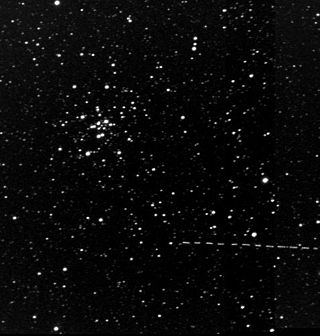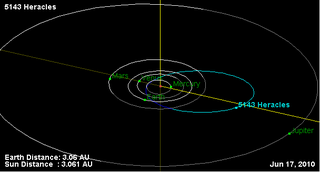Related Research Articles

(29075) 1950 DA is a risk-listed asteroid, classified as a near-Earth object and potentially hazardous asteroid of the Apollo group, approximately 1.3 kilometers in diameter. It once had the highest known probability of impacting Earth. In 2002, it had the highest Palermo rating with a value of 0.17 and a probability of 1 in 306 (0.33%) for a possible collision in 2880. Since that time, the estimated risk has been updated several times. In December 2015, the odds of an Earth impact were revised to 1 in 8,300 (0.012%) with a Palermo rating of −1.42. As of January 2025, it is listed on the Sentry Risk Table with the second highest cumulative Palermo rating of −0.92. 1950 DA is not assigned a Torino scale rating, because the 2880 date is over 100 years in the future. As of 23 January 2025, the odds of an Earth impact are 1 in 2,600 (0.039%).

1620 Geographos is a highly elongated, stony asteroid, near-Earth object and potentially hazardous asteroid of the Apollo group, with a mean diameter of approximately 2.5 km (1.6 mi). It was discovered on 14 September 1951, by astronomers Albert George Wilson and Rudolph Minkowski at the Palomar Observatory in California, United States. The asteroid was named in honor of the National Geographic Society.
2063 Bacchus, provisional designation 1977 HB, is a stony asteroid and near-Earth object of the Apollo group, approximately 1 kilometer in diameter. The contact binary was discovered on 24 April 1977, by American astronomer Charles Kowal at the Palomar Observatory in California, United States. It was named after Bacchus from Roman mythology.

4183 Cuno, provisional designation 1959 LM, is an eccentric, rare-type asteroid, classified as near-Earth object and potentially hazardous asteroid of the Apollo group, and measures approximately 4 kilometers in diameter.
4197 Morpheus, provisional designation 1982 TA, is a highly eccentric asteroid and near-Earth object of the Apollo group, approximately 3 kilometers in diameter. It was discovered on 11 October 1982, by American astronomers Eleanor Helin and Eugene Shoemaker at Palomar Observatory in California, United States. The asteroid was later named for Morpheus from Greek mythology.

1981 Midas, provisional designation 1973 EA, is a vestoid asteroid, classified as a near-Earth object and potentially hazardous asteroid, approximately 2 kilometers in diameter.

(33342) 1998 WT24 is a bright, sub-kilometer asteroid, classified as near-Earth object and potentially hazardous asteroid (PHA) of the Aten group, located in Venus's zone of influence that has frequent close encounters with Mercury, Venus, and Earth. It made a close approach to Earth on 11 December 2015, passing at a distance of about 4.2 million kilometers (2.6 million miles, 11 lunar distances) and reaching about apparent magnitude 11.

3752 Camillo is an inclined contact-binary asteroid, classified as near-Earth object of the Apollo group, approximately 2.3 kilometers in diameter. It was discovered on 15 August 1985, by astronomers Eleanor Helin and Maria Barucci using a 0.9-metre (35 in) telescope at the CERGA Observatory in Caussols, France. Lightcurve studies by Petr Pravec in 1998 suggest that the assumed S-type asteroid has an elongated shape and a longer-than average rotation period of 38 hours.
3212 Agricola, provisional designation 1938 DH2, is a stony Flora asteroid from the inner regions of the asteroid belt, approximately 5 km (3.1 miles) in diameter. It was discovered by Finnish astronomer Yrjö Väisälä at Turku Observatory in Southwest Finland, on 19 February 1938, and named after reformer Mikael Agricola.
1736 Floirac, provisional designation 1967 RA, is a stony Florian asteroid from the inner regions of the asteroid belt, approximately 8.7 kilometer in diameter.

3122 Florence is a stony trinary asteroid of the Amor group. It is classified as a near-Earth object and potentially hazardous asteroid. It measures approximately 5 kilometers in diameter. It orbits the Sun at a distance of 1.0–2.5 AU once every 2 years and 4 months ; the orbit has an eccentricity of 0.42 and an inclination of 22° with respect to the ecliptic. Florence has two moons.

5143 Heracles is a highly eccentric, rare-type asteroid and synchronous binary system, classified as near-Earth object of the Apollo group, approximately 4.8 kilometers in diameter. The asteroid was discovered on 7 November 1991, by American astronomer Carolyn Shoemaker at Palomar Observatory in California, United States. It is named for the Greek divine hero Heracles. It has an Earth minimum orbit intersection distance of 0.058 AU (8.7 million km) and is associated with the Beta Taurids daytime meteor shower.
7088 Ishtar, provisional designation 1992 AA, is a synchronous binary asteroid and near-Earth object from the Amor group, approximately 1.3 kilometers in diameter. It was discovered on 1 January 1992, by American astronomer Carolyn Shoemaker at the Palomar Observatory in California. The relatively bright asteroid with an unknown spectral type has a rotation period of 2.7 hours. In December 2005, a 330-meter sized satellite was discovered, orbiting its primary every 20.65 hours.
8116 Jeanperrin, provisional designation 1996 HA15, is a Florian asteroid and synchronous binary system from the inner regions of the asteroid belt, approximately 4.8 kilometers (3 miles) in diameter. It was discovered on 17 April 1996, by Belgian astronomer Eric Elst at the La Silla Observatory in northern Chile. The likely stony S-type asteroid has a rotation period of 3.62 hours and a nearly round shape. It was named for French physicist and Nobel laureate Jean Baptiste Perrin. A minor-planet moon, a third the size of its primary, was discovered in 2007.
19763 Klimesh is a stony Phocaea asteroid and slow rotator from the inner regions of the asteroid belt, approximately 7 kilometers in diameter. Discovered by NEAT at Haleakala Observatory in 2000, the asteroid was named for NEAT's software specialist Matthew Klimesh.
12923 Zephyr (prov. designation:1999 GK4) is a stony asteroid, classified as potentially hazardous asteroid and near-Earth object of the Apollo group, approximately 2 kilometers (1.2 miles) in diameter. It was discovered on 11 April 1999, by astronomers of the Lowell Observatory Near-Earth Object Search at Anderson Mesa Station near Flagstaff, Arizona. The asteroid was named after the deity Zephyrus from Greek mythology.
1573 Väisälä, provisional designation 1949 UA, is a stony Phocaea asteroid, slow rotator and suspected tumbler from the inner regions of the asteroid belt, approximately 9 kilometers in diameter. It was discovered on 27 October 1949, by Belgian astronomer Sylvain Arend at the Royal Observatory of Belgium in Uccle, Belgium. It was named for Finnish astronomer Yrjö Väisälä.
4949 Akasofu, provisional designation 1988 WE, is a stony Flora asteroid from the inner regions of the asteroid belt, approximately 5 kilometers in diameter. It was discovered by Japanese amateur astronomer Takuo Kojima at the YGCO Chiyoda Station in Japan on 29 November 1988. The asteroid was named for Japanese geophysicist Syun-Ichi Akasofu
(8201) 1994 AH2 is a highly eccentric, rare-type asteroid, classified as near-Earth object of the Apollo group of asteroids, approximately 2 kilometers in diameter. It was discovered on 5 January 1994, by Australian amateur astronomer Gordon Garradd during the AANEAS survey at the Siding Spring Observatory, Australia. It has an Earth minimum orbit intersection distance of 0.1 AU (15 million km) and is associated with the Beta Taurids daytime meteor shower.

(66063) 1998 RO1 is a stony near-Earth object of the Aten group on a highly-eccentric orbit. The synchronous binary system measures approximately 800 meters (0.50 miles) in diameter. It was discovered by astronomers of the Lincoln Near-Earth Asteroid Research at the Lincoln Laboratory's Experimental Test Site near Socorro, New Mexico, on 14 September 1998.
References
- 1 2 3 4 5 6 7 8 9 10 "JPL Small-Body Database Browser: 6178 (1986 DA)" (2015-07-28 last obs.). Jet Propulsion Laboratory . Retrieved 26 May 2017.
- 1 2 3 "6178 (1986 DA)". Minor Planet Center. Retrieved 26 May 2016.
- 1 2 3 4 Pravec, Petr; Harris, Alan W.; Kusnirák, Peter; Galád, Adrián; Hornoch, Kamil (September 2012). "Absolute magnitudes of asteroids and a revision of asteroid albedo estimates from WISE thermal observations". Icarus. 221 (1): 365–387. Bibcode:2012Icar..221..365P. doi:10.1016/j.icarus.2012.07.026.
- 1 2 3 "LCDB Data for (6178)". Asteroid Lightcurve Database (LCDB). Retrieved 26 May 2016.
- 1 2 3 4 Mainzer, A.; Grav, T.; Masiero, J.; Hand, E.; Bauer, J.; Tholen, D.; et al. (November 2011). "NEOWISE Studies of Spectrophotometrically Classified Asteroids: Preliminary Results". The Astrophysical Journal. 741 (2): 25. arXiv: 1109.6407 . Bibcode:2011ApJ...741...90M. doi:10.1088/0004-637X/741/2/90. S2CID 118700974.
- 1 2 Zeigler, K. W. (March 1990). "Photoelectric Photometry of Asteroids 81 Terpsichore, 381 Myrrha, and 1986 DA". The Minor Planet Bulletin. 17: 1. Bibcode:1990MPBu...17....1Z.
- 1 2 3 Wisniewski, W. Z. (June 1987). "Photometry of six radar target asteroids". Icarus. 70 (3): 566–572. Bibcode:1987Icar...70..566W. doi:10.1016/0019-1035(87)90096-0. ISSN 0019-1035.
- 1 2 Ostro, S. J.; Rosema, K. D.; Campbell, D. B.; Chandler, J. F.; Hine, A. A.; Hudson, R. S. (June 1991). "Asteroid 1986 DA - Radar evidence for a metallic composition". Science. 252 (5011): 1399–1404.NASA–supportedresearch.(SciHomepage). Bibcode:1991Sci...252.1399O. doi:10.1126/science.252.5011.1399. hdl: 2060/19920003664 . ISSN 0036-8075. PMID 17772910. S2CID 2510757.
- ↑ "Near-Earth Metal Asteroid Discovered". NASA/JPL. Retrieved 30 October 2018.
- ↑ Ostro, Steven J.; Campbell, D. B.; Chandler, J. F.; Hine, A. A.; Hudson, R. S.; Rosema, K. D.; et al. (October 1991). "Asteroid 1986 DA: Radar evidence for a metallic composition". In NASA. 252 (5011): 1399–1704. Bibcode:1991plas.rept..174O. doi:10.1126/science.252.5011.1399. hdl: 2060/19920003664 . PMID 17772910. S2CID 2510757.
- ↑ "Delta-v for spacecraft rendezvous with all known near-Earth asteroids". NASA. 1 June 2006. Archived from the original on 3 June 2001. Retrieved 8 June 2006.